Heavy Metal Removal from Wastewater Using Poly(Gamma-Glutamic Acid)-Based Hydrogel
Abstract
:1. Introduction
2. Results and Discussion
2.1. Characterizations of the Hydrogel
2.2. Adsorption Performance of PGA Hydrogels
2.2.1. Adsorption Kinetics
2.2.2. Adsorption Isotherm
2.2.3. Adsorption Thermodynamics
2.2.4. Effect of Solution pH on Adsorption
2.2.5. Effect of the Mass of the Adsorbent on Adsorption
2.2.6. Reusability
2.2.7. Adsorption of Other Heavy Metal Cations
2.3. Adsorption Mechanism
3. Conclusions
4. Materials and Methods
4.1. Materials and Instruments
4.2. Characterizations
4.3. Preparation of Hydrogel
4.4. Determination of Cu2+ Concentration
4.5. Adsorption Kinetics
4.6. Adsorption Isotherms
4.7. Adsorption Thermodynamics
4.8. Effect of the Solution pH on Adsorption
4.9. Effect of the Mass of the Adsorbent on Adsorption
4.10. Reusability
4.11. Swelling Behavior of the Hydrogels
Author Contributions
Funding
Institutional Review Board Statement
Informed Consent Statement
Data Availability Statement
Conflicts of Interest
References
- Tang, S.; Yang, J.; Lin, L.; Peng, K.; Chen, Y.; Jin, S.; Yao, W. Construction of physically crosslinked chitosan/sodium alginate/calcium ion double-network hydrogel and its application to heavy metal ions removal. Chem. Eng. J. 2020, 393, 124728. [Google Scholar] [CrossRef]
- Izydorczyk, G.; Mikula, K.; Skrzypczak, D.; Moustakas, K.; Witek-Krowiak, A.; Chojnacka, K. Potential environmental pollution from copper metallurgy and methods of management. Environ. Res. 2021, 197, 111050. [Google Scholar] [CrossRef]
- Wang, H.; Chen, N.; Cui, Y.; Liu, Y. Removal of copper ions from wastewater: A Review. Int. J. Environ. Res. Public Health 2023, 20, 3885. [Google Scholar] [CrossRef]
- Rehman, M.; Liu, L.; Wang, Q.; Saleem, M.H.; Bashir, S.; Ullah, S.; Peng, D. Copper environmental toxicology, recent advances, and future outlook: A review. Environ. Sci. Pollut. Res. 2019, 26, 18003–18016. [Google Scholar] [CrossRef]
- Shen, C.; Zhao, Y.; Li, W.; Yang, Y.; Liu, R.; Morgen, D. Global profile of heavy metals and semimetals adsorption using drinking water treatment residual. Chem. Eng. J. 2019, 372, 1019–1027. [Google Scholar] [CrossRef]
- Bayuo, J.; Rwiza, M.J.; Sillanpää, M.; Mtei, K.M. Removal of heavy metals from binary and multicomponent adsorption systems using various adsorbents—A systematic review. RSC Adv. 2023, 13, 13052–13093. [Google Scholar] [CrossRef]
- Wang, J.; Guo, X. Adsorption kinetics and isotherm models of heavy metals by various adsorbents: An overview. Crit. Rev. Environ. Sci. Technol. 2023, 53, 1837–1865. [Google Scholar] [CrossRef]
- Rajendran, S.; Priya, A.K.; Kumar, P.S.; Hoang, T.K.A.; Sekar, K.; Chong, K.Y.; Khoo, K.S.; Ng, H.S.; Show, P.L. A critical and recent developments on adsorption technique for removal of heavy metals from wastewater—A review. Chemosphere 2022, 303, 135146. [Google Scholar] [CrossRef]
- Tran, N.N.; Escribà-Gelonch, M.; Sarafraz, M.M.; Pho, Q.H.; Sagadevan, S.; Hessel, V. Process technology and sustainability assessment of wastewater treatment. Ind. Eng. Chem. Res. 2023, 62, 1195–1214. [Google Scholar] [CrossRef]
- Zhang, T.; Wang, F.; Zhou, B. Microbial-Based Heavy Metal Bioremediation: Toxicity and eco-friendly approaches to heavy metal decontamination. Appl. Sci. 2023, 13, 8439. [Google Scholar] [CrossRef]
- Yudaev, P.; Chistyakov, E. Chelating Extractants for Metals. Metals 2022, 12, 1275. [Google Scholar] [CrossRef]
- Peng, Y.-P.; Chang, Y.-C.; Chen, K.-F.; Wang, C.-H. A field pilot-scale study on heavy metal-contaminated soil washing by using an environmentally friendly agent—Poly-γ-glutamic acid (γ-PGA). Environ. Sci. Pollut. Res. 2020, 27, 34760–34769. [Google Scholar] [CrossRef]
- Mark, S.S.; Crusberg, T.C.; DaCunha, C.M.; Iorio, A.A.D. A heavy metal biotrap for wastewater remediation using poly-γ-glutamic acid. Biotechnol. Prog. 2006, 22, 523–531. [Google Scholar] [CrossRef]
- Wang, L.; Liu, Y.; Shu, X.; Lu, S.; Xie, X.; Shi, Q. Complexation and conformation of lead ion with poly-γ-glutamic acid in soluble state. PLoS ONE 2019, 14, e0218742. [Google Scholar] [CrossRef]
- Fei, Y.; Hu, Y.H. Design, synthesis, and performance of adsorbents for heavy metal removal from wastewater: A review. J. Mater. Chem. A 2022, 10, 1047–1085. [Google Scholar] [CrossRef]
- Khan, M.; Lo, I.M.C. A holistic review of hydrogel applications in the adsorptive removal of aqueous pollutants: Recent progress, challenges, and perspectives. Water Res. 2016, 106, 259–271. [Google Scholar] [CrossRef]
- ALSamman, M.T.; Sánchez, J. Recent advances on hydrogels based on chitosan and alginate for the adsorption of dyes and metal ions from water. Arab. J. Chem. 2021, 14, 103455. [Google Scholar] [CrossRef]
- Samaddar, P.; Kumar, S.; Kim, K.-H. Polymer hydrogels and their applications toward sorptive removal of potential aqueous pollutants. Polym. Rev. 2019, 59, 418–464. [Google Scholar] [CrossRef]
- Darban, Z.; Shahabuddin, S.; Gaur, R.; Ahmad, I.; Sridewi, N. Hydrogel-based adsorbent material for the effective removal of heavy metals from wastewater: A comprehensive review. Gels 2022, 8, 263. [Google Scholar] [CrossRef]
- Perumal, S.; Atchudan, R.; Edison, T.N.J.I.; Babu, R.S.; Karpagavinayagam, P.; Vedhi, C. A short review on recent advances of hydrogel-based adsorbents for heavy metal ions. Metals 2021, 11, 864. [Google Scholar] [CrossRef]
- Aoudi, B.; Boluk, Y.; El-Din, M.G. Recent advances and future perspective on nanocellulose-based materials in diverse water treatment applications. Sci. Total Environ. 2022, 843, 156903. [Google Scholar] [CrossRef] [PubMed]
- Zhang, Y.; Zhao, M.; Cheng, Q.; Wang, C.; Li, H.; Han, X.; Fan, Z.; Su, G.; Pan, D.; Li, Z. Research progress of adsorption and removal of heavy metals by chitosan and its derivatives: A review. Chemosphere 2021, 279, 130927. [Google Scholar] [CrossRef] [PubMed]
- Nangia, S.; Warkar, S.; Katyal, D. A review on environmental applications of chitosan biopolymeric hydrogel based composites. Macromol. Rep. 2018, 55, 747–763. [Google Scholar] [CrossRef]
- Alves, D.C.d.S.; Healy, B.; Yu, T.; Breslin, C.B. Graphene-based materials immobilized within chitosan: Applications as adsorbents for the removal of aquatic pollutants. Materials 2021, 14, 3655. [Google Scholar] [CrossRef] [PubMed]
- Chelu, M.; Musuc, A.M.; Popa, M.; Calderon Moreno, J.M. Chitosan hydrogels for water purification applications. Gels 2023, 9, 664. [Google Scholar] [CrossRef] [PubMed]
- Yudaev, P.; Butorova, I.; Stepanov, G.; Chistyakov, E. Extraction of palladium(ii) with a magnetic sorbent based on polyvinyl alcohol gel, metallic iron, and an environmentally friendly polydentate phosphazene-containing extractant. Gels 2022, 8, 492. [Google Scholar] [CrossRef] [PubMed]
- Panic, V.V.; Velickovic, S.J. Removal of model cationic dye by adsorption onto poly(methacrylic acid)/zeolite hydrogel composites: Kinetics, equilibrium study and image analysis. Sep. Purif. Technol. 2014, 122, 384–394. [Google Scholar] [CrossRef]
- Yang, Z.-H.; Dong, C.-D.; Chen, C.-W.; Sheu, Y.-T.; Kao, C.-M. Using poly-glutamic acid as soil-washing agent to remediate heavy metal-contaminated soils. Environ. Sci. Pollut. Res. 2018, 25, 5231–5242. [Google Scholar] [CrossRef]
- Hisada, M.; Kawase, Y. Recovery of rare-earth metal neodymium from aqueous solutions by poly-γ-glutamic acid and its sodium salt as biosorbents: Effects of solution pH on neodymium recovery mechanisms. J. Rare Earths 2018, 36, 528–536. [Google Scholar] [CrossRef]
- Hisada, M.; Kawase, Y. Mucilage extracted from wasted natto (fermented soybeans) as a low-cost poly-γ-glutamic acid based biosorbent: Removal of rare-earth metal Nd from aqueous solutions. J. Environ. Chem. Eng. 2017, 5, 6061–6069. [Google Scholar] [CrossRef]
- Hajdu, I.; Bodnár, M.; Csikós, Z.; Wei, S.; Daróczi, L.; Kovács, B.; Győri, Z.; Tamás, J.; Borbély, J. Combined nano-membrane technology for removal of lead ions. J. Membr. Sci. 2012, 409–410, 44–53. [Google Scholar] [CrossRef]
- Wang, F.; Zhao, J.; Wei, X.; Huo, F.; Li, W.; Hu, Q.; Liu, H. Adsorption of rare earths (III) by calcium alginate–poly glutamic acid hybrid gels. J. Chem. Technol. Biotechnol. 2014, 89, 969–977. [Google Scholar] [CrossRef]
- Jin, X.; Liu, Y.; Tan, J.; Owens, G.; Chen, Z. Removing Cr(VI) from aqueous solutions via absorption by green synthesized PGA-PL-tannin gel. Pol. J. Environ. Stud. 2020, 29, 1973–1980. [Google Scholar] [CrossRef]
- Duong, P.H.H.; Zuo, J.; Nunes, S.P. Dendrimeric thin-film composite membranes: Free volume, roughness, and fouling resistance. Ind. Eng. Chem. Res. 2017, 56, 14337–14349. [Google Scholar] [CrossRef]
- Yang, S.; Fu, S.; Liu, H.; Zhou, Y.; Li, X. Hydrogel beads based on carboxymethyl cellulose for removal heavy metal ions. J. Appl. Polym. Sci. 2011, 119, 1204–1210. [Google Scholar] [CrossRef]
- Mubark, A.E.; Hakem, H.A.; Zaki, E.G.; Elsaeed, S.M.; Abdel-Rahman, A.A.-H. Sequestration of Cd(II) and Cu(II) ions using bio-based hydrogel: A study on the adsorption isotherms and kinetics. Int. J. Environ. Sci. Technol. 2022, 19, 10877–10892. [Google Scholar] [CrossRef]
- Teow, Y.H.; Kam, L.M.; Mohammad, A.W. Synthesis of cellulose hydrogel for copper (II) ions adsorption. J. Environ. Chem. Eng. 2018, 6, 4588–4597. [Google Scholar] [CrossRef]
- Chowdhury, M.N.K.; Ismail, A.F.; Beg, M.D.H.; Hegde, G.; Gohari, R.J. Polyvinyl alcohol/polysaccharide hydrogel graft materials for arsenic and heavy metal removal. New J. Chem. 2015, 39, 5823–5832. [Google Scholar] [CrossRef]
- Romal, J.R.A.; Ong, S.K. Single-Step fabrication of a dual-sensitive chitosan hydrogel by c-mannich reaction: Synthesis, physicochemical properties, and screening of its Cu2+ uptake. Processes 2023, 11, 354. [Google Scholar] [CrossRef]
- Dai, J.; Yan, H.; Yang, H.; Cheng, R. Simple method for preparation of chitosan/poly(acrylic acid) blending hydrogel beads and adsorption of copper(II) from aqueous solutions. Chem. Eng. J. 2010, 165, 240–249. [Google Scholar] [CrossRef]
- Yan, H.; Dai, J.; Yang, Z.; Yang, H.; Cheng, R. Enhanced and selective adsorption of copper(II) ions on surface carboxymethylated chitosan hydrogel beads. Chem. Eng. J. 2011, 174, 586–594. [Google Scholar] [CrossRef]
- Wu, X.; Wang, A.; Zheng, X.; Li, G.; Dong, X.; Wu, M. Study on optimal conditions and adsorption kinetics of copper from water by collodion membrane cross-linked poly-γ-glutamic acid. Korean J. Chem. Eng. 2013, 30, 1295–1300. [Google Scholar] [CrossRef]
- Chen, X.; Huang, Z.; Luo, S.-Y.; Zong, M.-H.; Lou, W.-Y. Multi-functional magnetic hydrogels based on Millettia speciosa Champ residue cellulose and Chitosan: Highly efficient and reusable adsorbent for Congo red and Cu2+ removal. Chem. Eng. J. 2021, 423, 130198. [Google Scholar] [CrossRef]
- Inbaraj, B.S.; Chen, B.-H. In vitro removal of toxic heavy metals by poly(γ-glutamic acid)-coated superparamagnetic nanoparticles. Int. J. Nanomed. 2012, 7, 4419–4432. [Google Scholar] [CrossRef]
- Inbaraj, B.S.; Chen, B.H. Dye adsorption characteristics of magnetite nanoparticles coated with a biopolymer poly(γ-glutamic acid). Bioresour. Technol. 2011, 102, 8868–8876. [Google Scholar] [CrossRef] [PubMed]
- Kolařík, J.; Bakandritsos, A.; Bad’ura, Z.; Lo, R.; Zoppellaro, G.; Kment, Š.; Naldoni, A.; Zhang, Y.; Petr, M.; Tomanec, O.; et al. Carboxylated graphene for radical-assisted ultra-trace-level water treatment and noble metal recovery. Acs Nano 2021, 15, 3349–3358. [Google Scholar] [CrossRef] [PubMed]
- Huang, Z.; Liu, S.; Zhang, B.; Xu, L.; Hu, X. Equilibrium and kinetics studies on the absorption of Cu(II) from the aqueous phase using a β-cyclodextrin-based adsorbent. Carbohydr. Polym. 2012, 88, 609–617. [Google Scholar] [CrossRef]
- Hamza, M.F.; Wei, Y.; Guibal, E. Quaternization of algal/PEI beads (a new sorbent): Characterization and application to scandium sorption from aqueous solutions. Chem. Eng. J. 2020, 383, 123210. [Google Scholar] [CrossRef]
- Stevens, J.S.; Luca, A.C.d.; Pelendritis, M.; Terenghi, G.; Downes, S.; Schroeder, S.L.M. Quantitative analysis of complex amino acids and RGD peptides by X-ray photoelectron spectroscopy (XPS). Surf. Interface Anal. 2013, 45, 1238–1246. [Google Scholar] [CrossRef]
- Ding, J.; Zhang, C.; Zhang, J.; Liu, H.; Yu, G.; Yu, T.; Wang, Y.; Guo, X.; Ding, J.D.J.D.J.; Zhang, C.Z.C.Z.C.; et al. Comparative study on CuO–La2O3/ZrO2 catalysts prepared by amino acid complexing-combustion in CO2 hydrogenation. Asia-Pac. J. Chem. Eng. 2023, 18, e2879. [Google Scholar] [CrossRef]
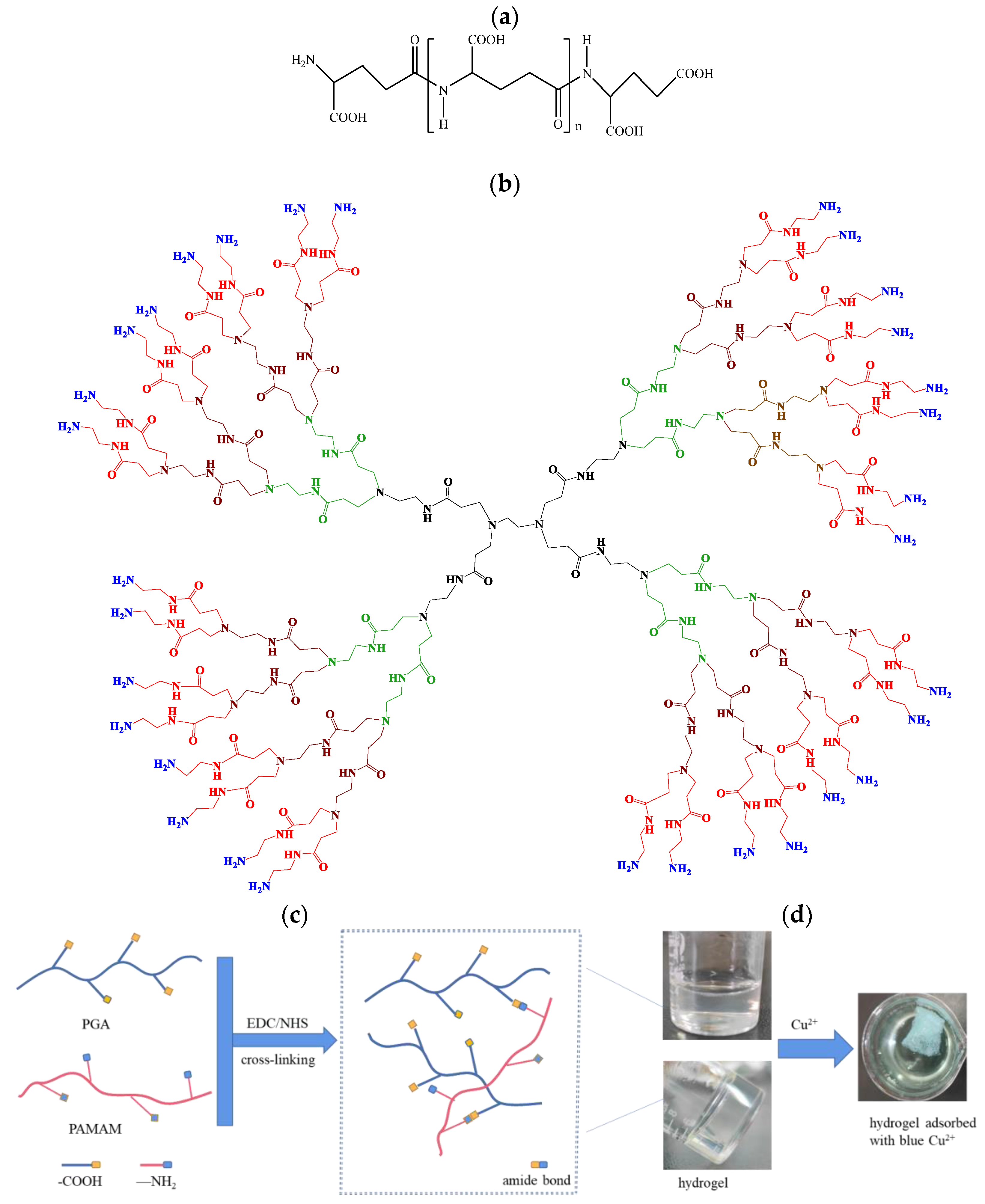
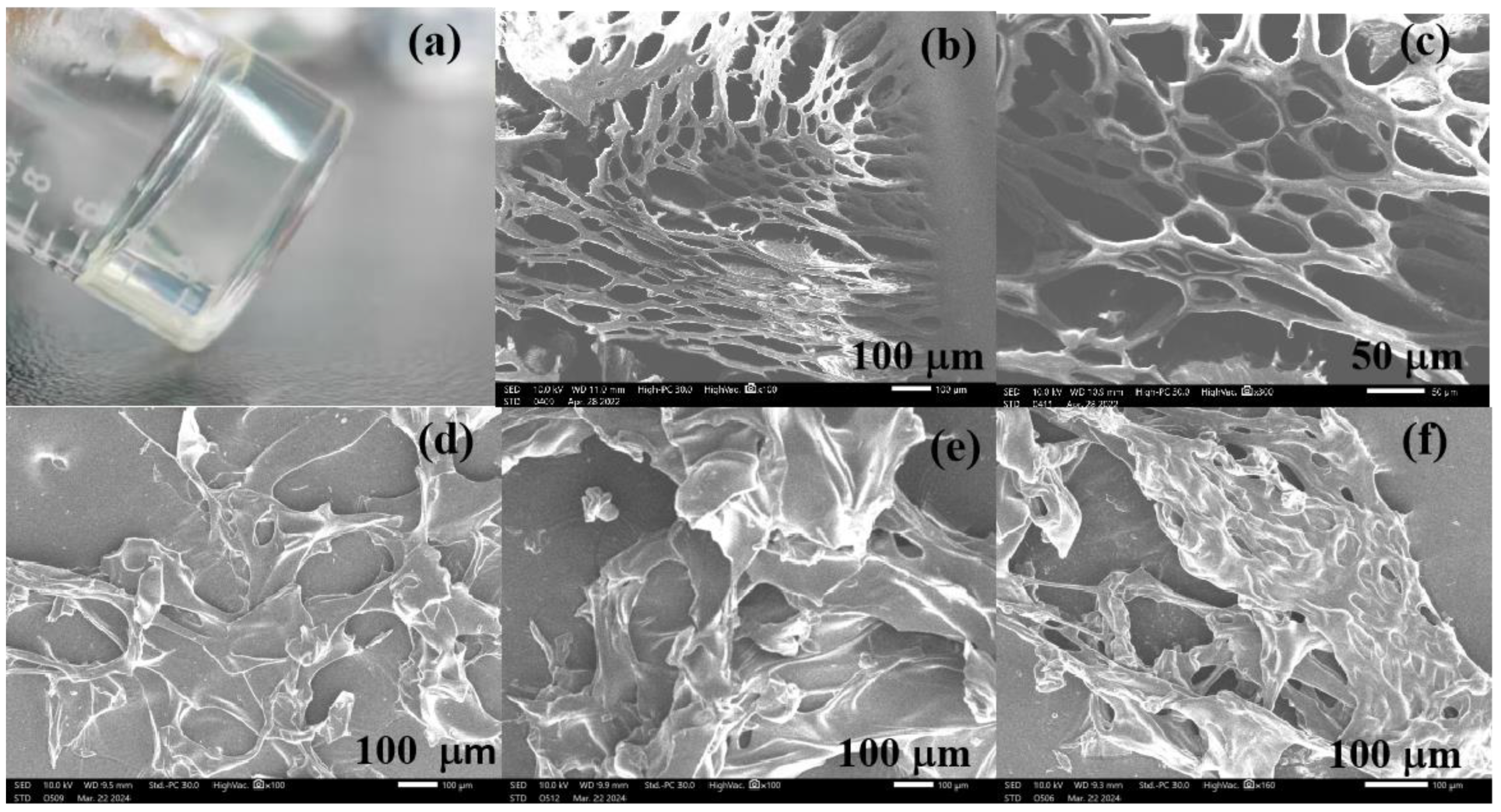

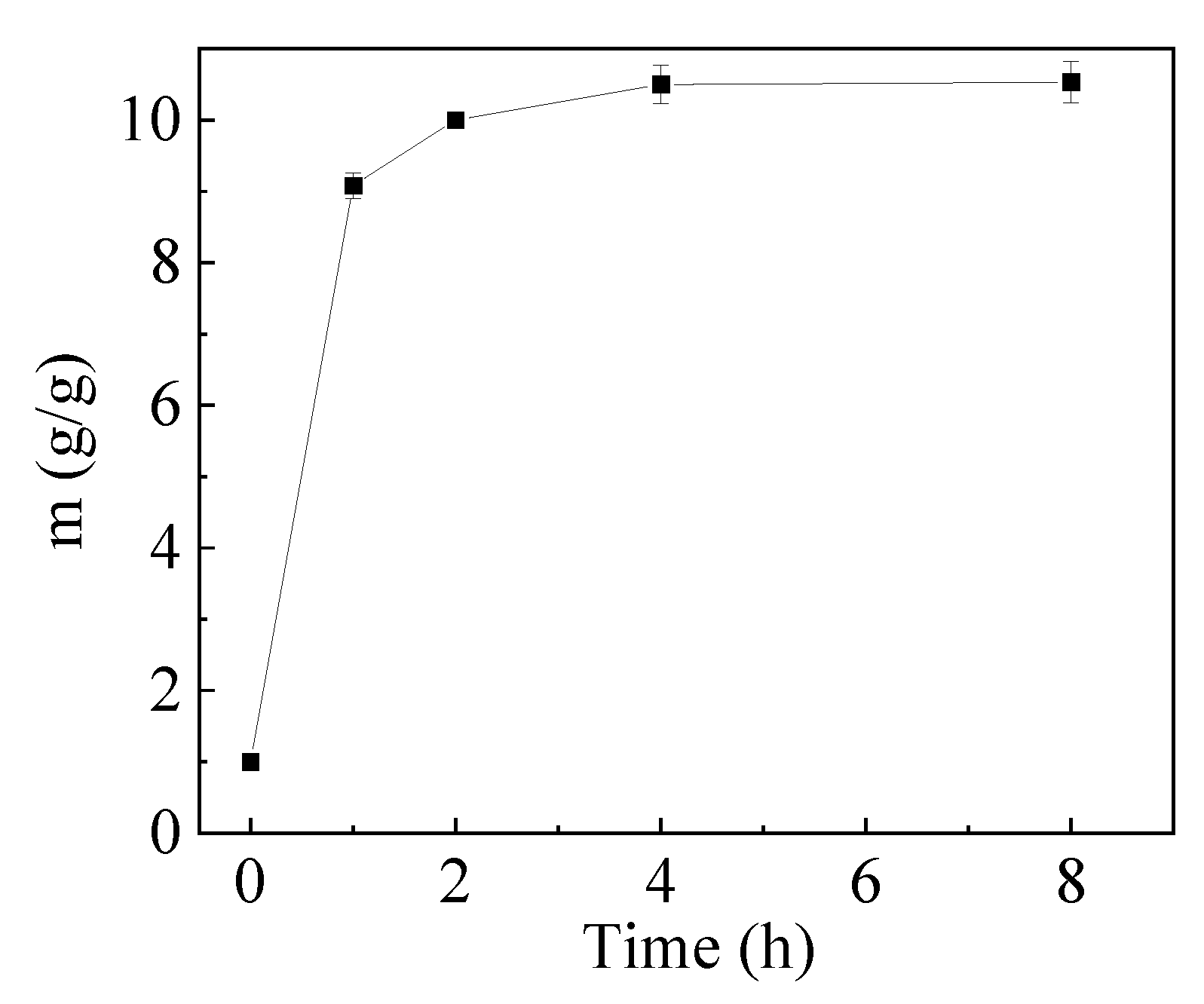
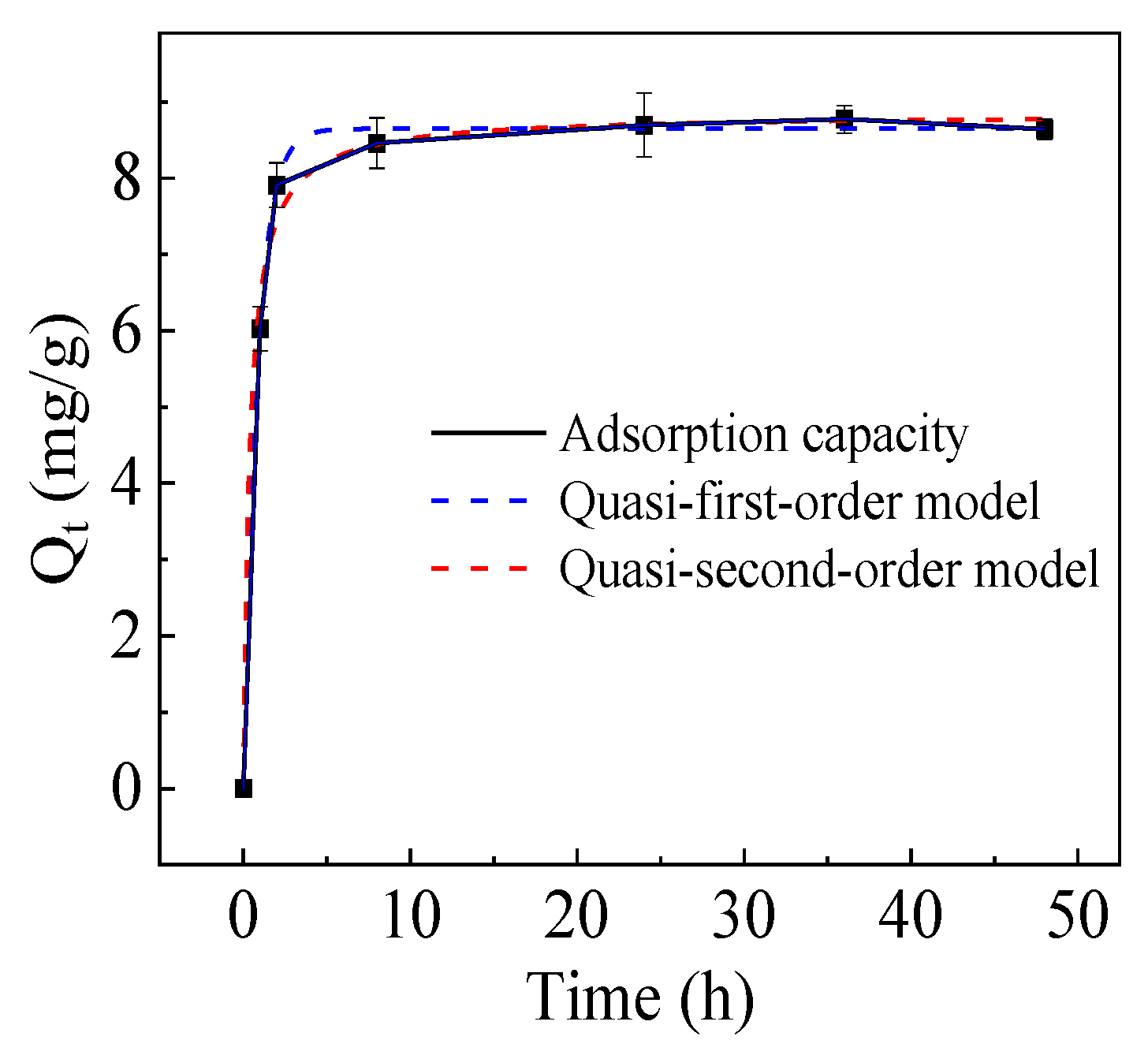

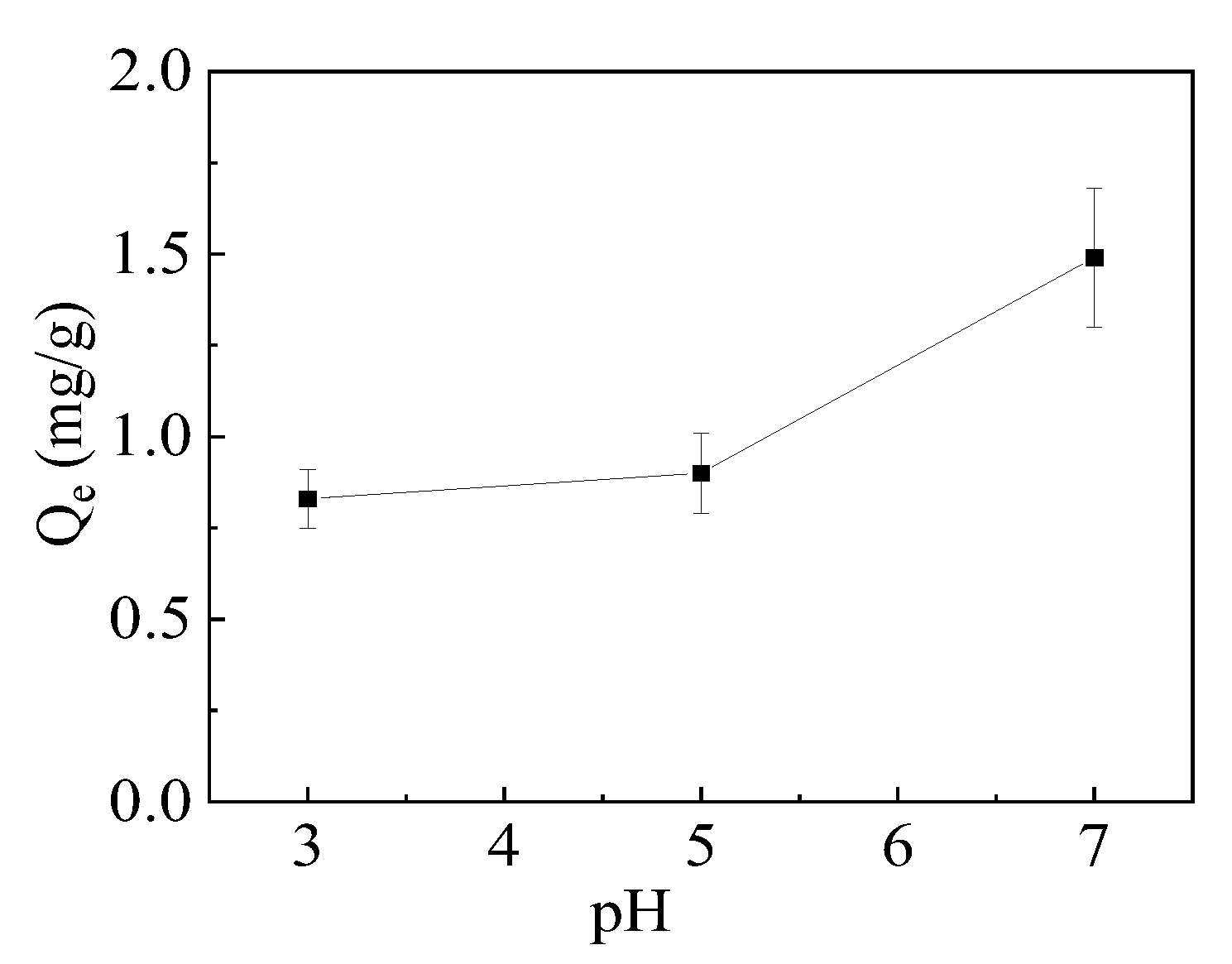
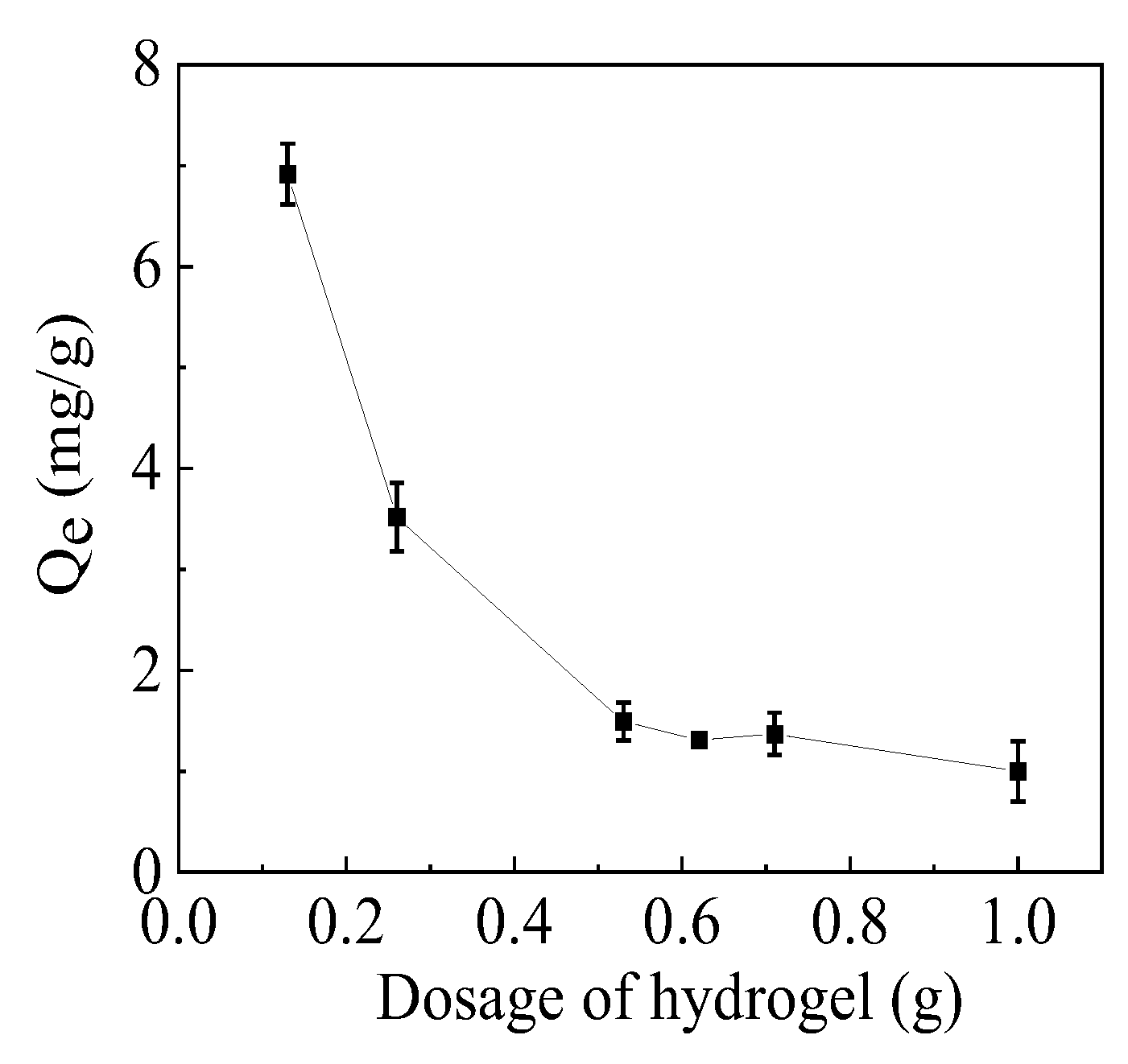
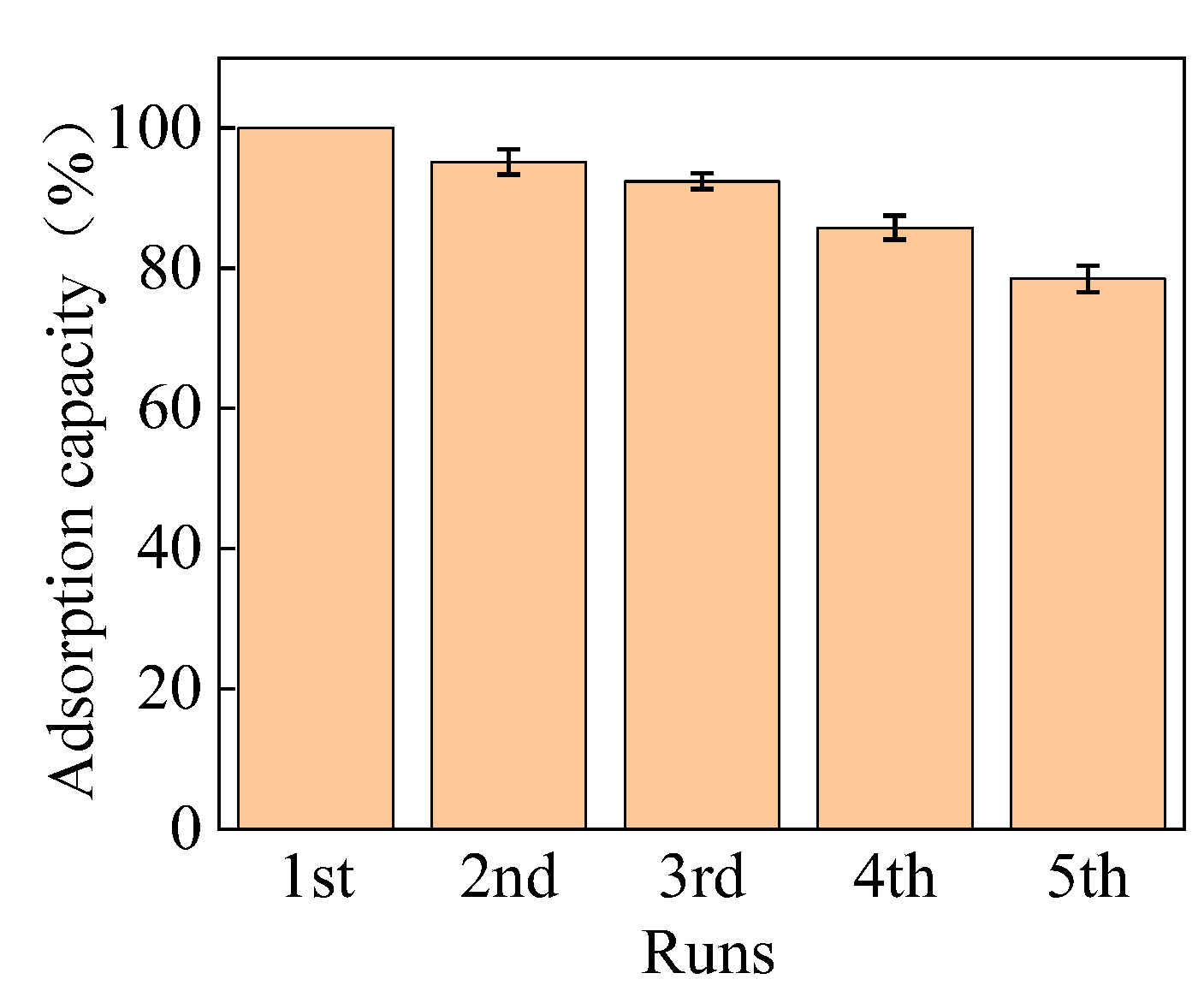
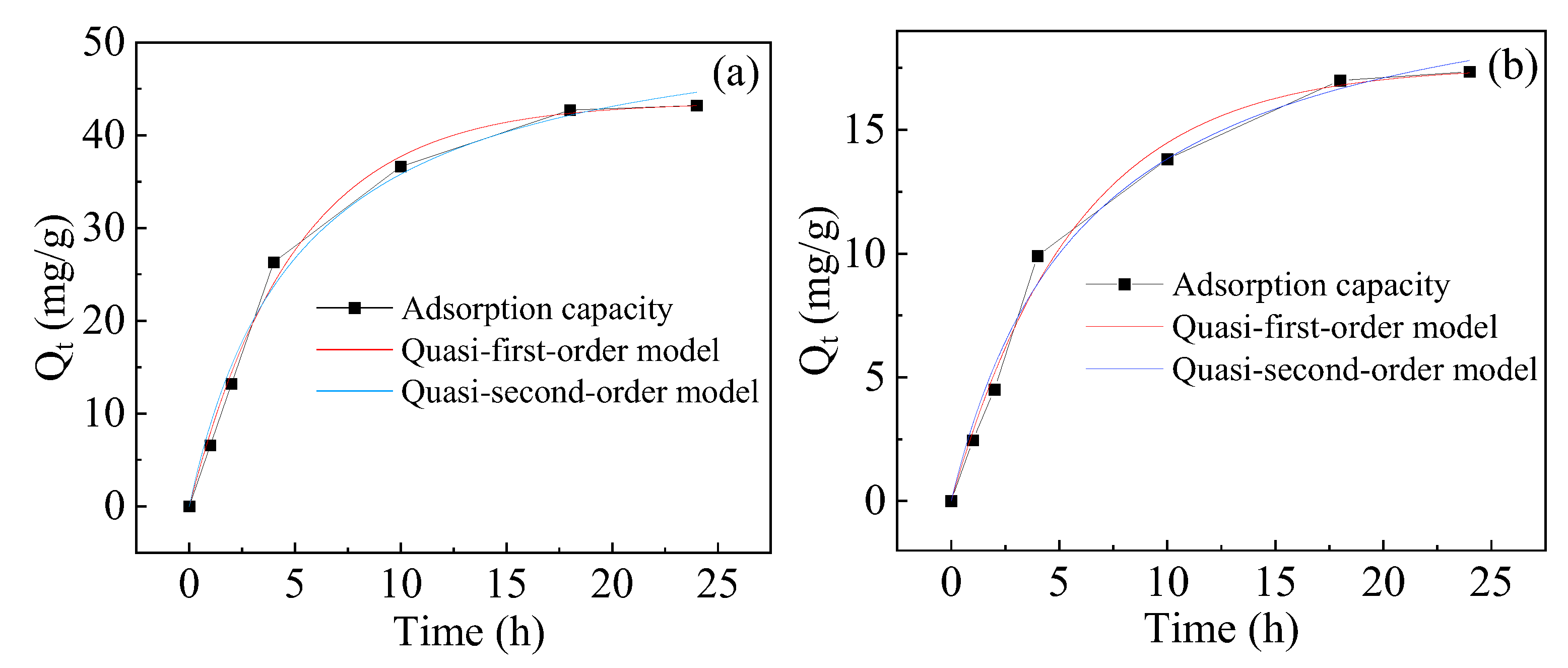

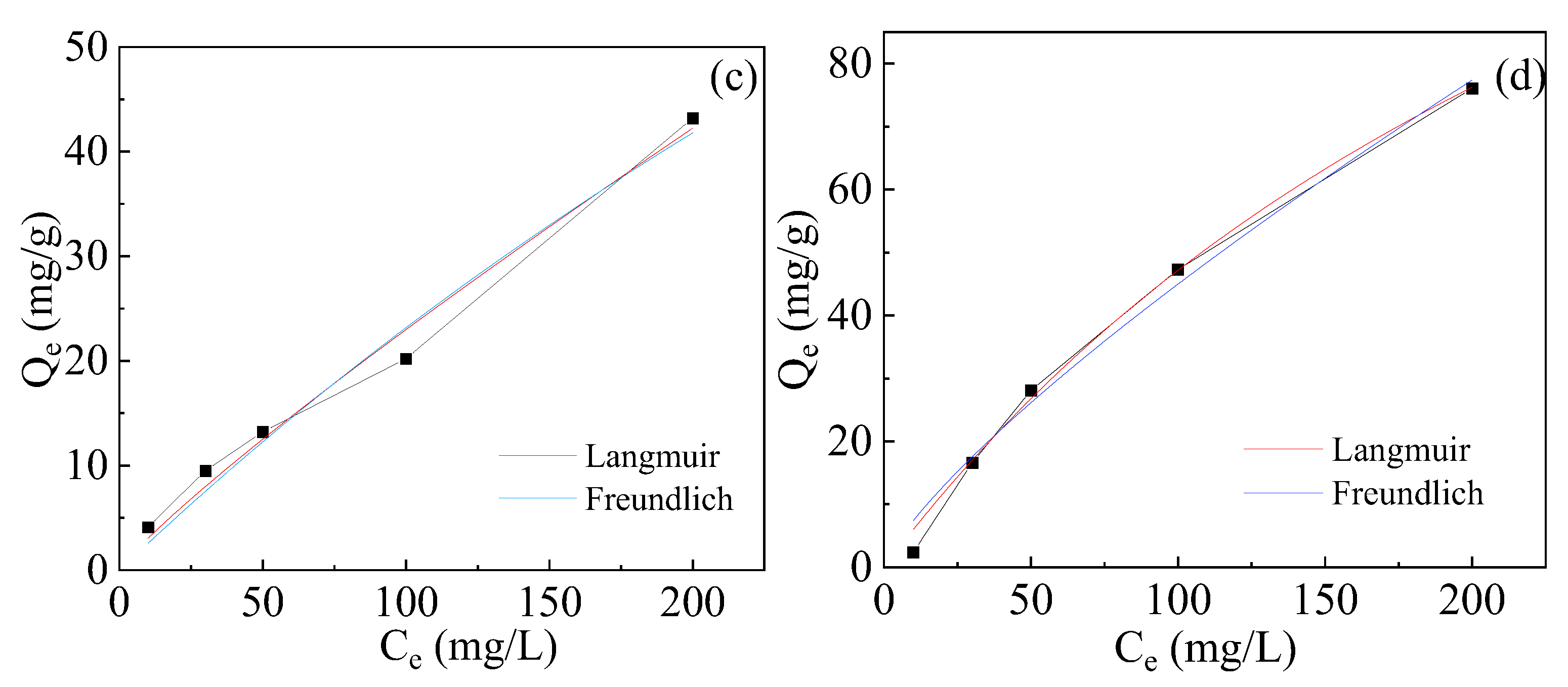
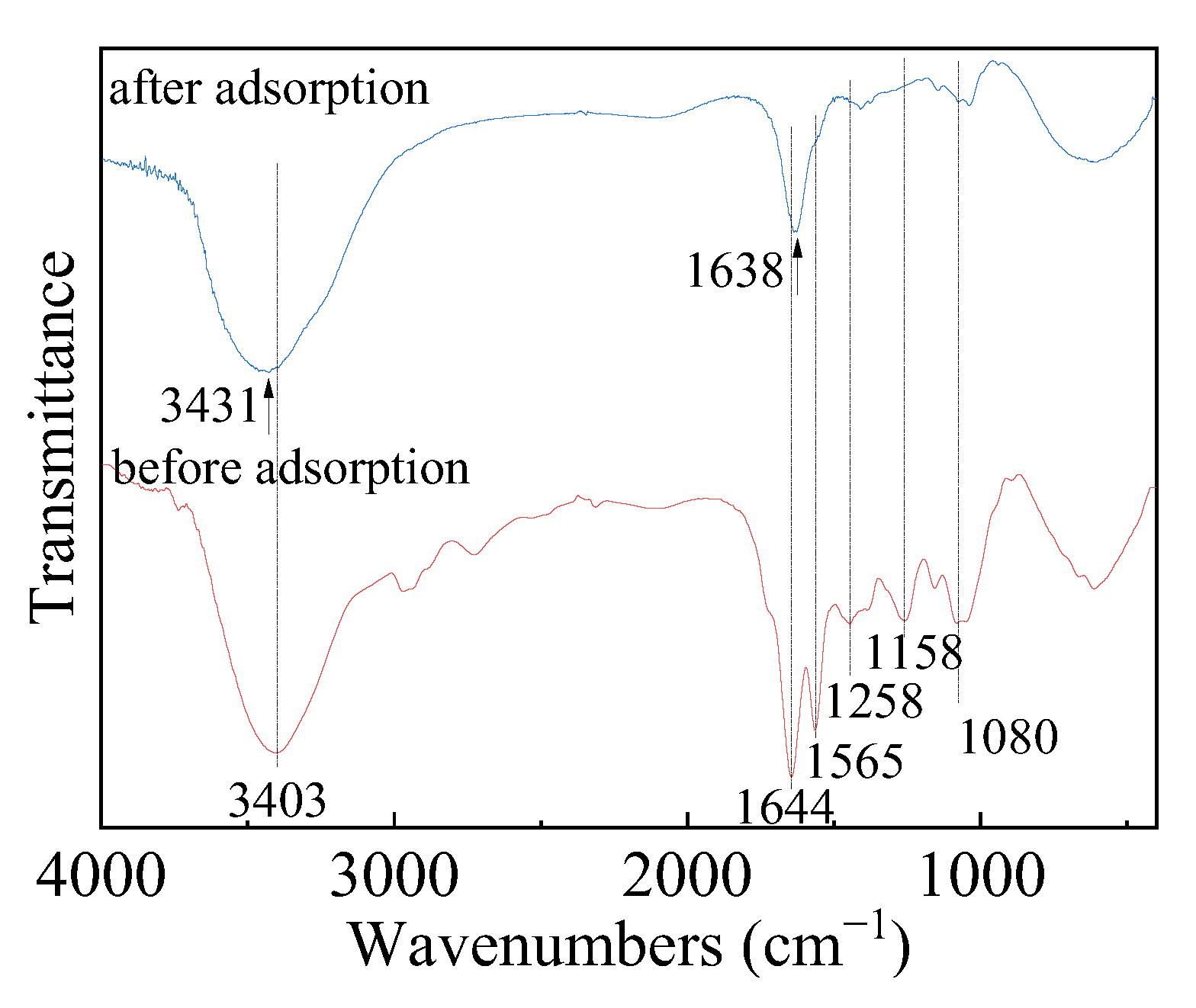
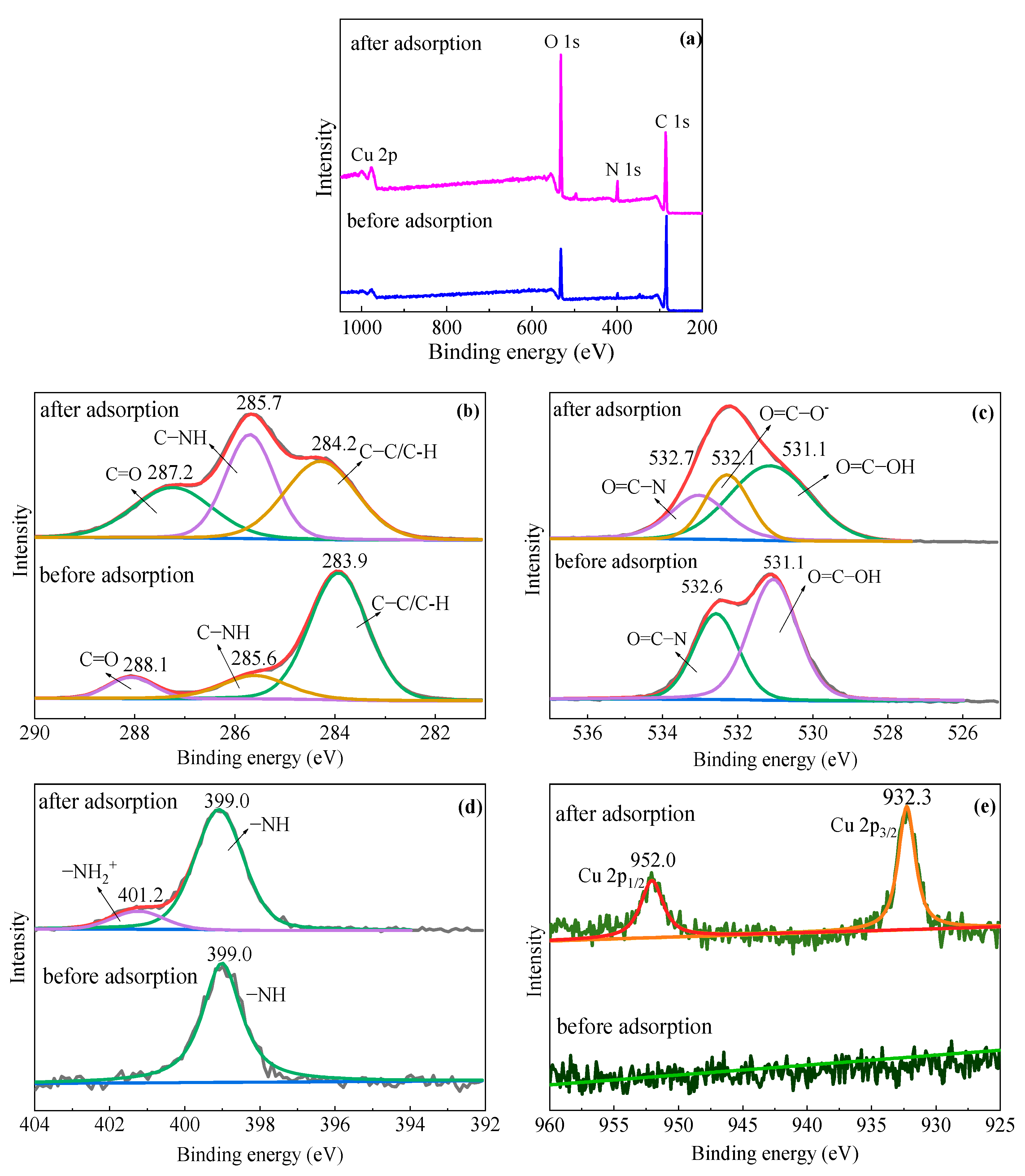
| Qe (mg/g) | Pseudo-First-Order | Pseudo-Second-Order | ||||
|---|---|---|---|---|---|---|
| qe1 (mg g−1) | k1 (min−1) | R2 | qe2 (mg g−1) | k2 (g mg−1 min−1) | R2 | |
| 8.6 ± 0.1 | 8.64 | 9.04 × 10−2 | 0.9989 | 8.84 | 0.2974 | 0.9261 |
| Langmuir Model | Freundlich Model | ||||
|---|---|---|---|---|---|
| Qm (mg g−1) | KL (L mg−1) | R2 | KF (Ln mgn−1/n g−1) | 1/n | R2 |
| 21.41 | 0.0069 | 0.9863 | 0.2833 | 0.7466 | 0.9781 |
| ΔH0 (kJ·mol−1) | ΔS0 (kJ·mol−1·K−1) | ΔG0 (kJ·mol−1) | R2 | ||
|---|---|---|---|---|---|
| 298 K | 318 K | 328 K | |||
| −1792.42 | −5.4252 | −175.70 | −67.20 | −12.95 | 0.9999 |
| Metal Ions | Qe (mg/g) | Pseudo-First-Order | Pseudo-Second-Order | ||||
|---|---|---|---|---|---|---|---|
| qe1 (mg g−1) | k1 (min−1) | R2 | qe2 (mg g−1) | k2 (g mg−1 min−1) | R2 | ||
| Zn2+ | 43.2 | 43.52 | 0.2011 | 0.9938 | 54.1 | 0.0035 | 0.9881 |
| Cr6+ | 17.35 | 17.57 | 0.1735 | 0.9910 | 22.41 | 0.0071 | 0.9883 |
| Heavy Metal Ions | Langmuir Model | Freundlich Model | ||||
|---|---|---|---|---|---|---|
| Qm (mg g−1) | KL (L mg−1) | R2 | KF (Ln mgn−1/n g−1) | 1/n | R2 | |
| Zn2+ | 212.3 | 0.0012 | 0.9994 | 0.4039 | 0.8774 | 0.9819 |
| Cr6+ | 198.63 | 0.0031 | 0.9939 | 1.2225 | 0.7829 | 0.9850 |
| Heavy Metal Ions | ΔH0 (kJ·mol−1) | ΔS0 (kJ·mol−1·K−1) | ΔG0 (kJ·mol−1) | R2 | ||
|---|---|---|---|---|---|---|
| 298 K | 308 K | 318 K | ||||
| Zn2+ | 0.12238 | 0.00046 | −0.0147 | −0.0193 | −0.024 | 0.9863 |
| Cr6+ | 0.3635 | 0.0013 | −0.0477 | −0.0615 | −0.0729 | 0.9999 |
Disclaimer/Publisher’s Note: The statements, opinions and data contained in all publications are solely those of the individual author(s) and contributor(s) and not of MDPI and/or the editor(s). MDPI and/or the editor(s) disclaim responsibility for any injury to people or property resulting from any ideas, methods, instructions or products referred to in the content. |
© 2024 by the authors. Licensee MDPI, Basel, Switzerland. This article is an open access article distributed under the terms and conditions of the Creative Commons Attribution (CC BY) license (https://creativecommons.org/licenses/by/4.0/).
Share and Cite
Chen, F.; Zhao, Y.; Zhao, H.; Zhou, X.; Liu, X. Heavy Metal Removal from Wastewater Using Poly(Gamma-Glutamic Acid)-Based Hydrogel. Gels 2024, 10, 259. https://doi.org/10.3390/gels10040259
Chen F, Zhao Y, Zhao H, Zhou X, Liu X. Heavy Metal Removal from Wastewater Using Poly(Gamma-Glutamic Acid)-Based Hydrogel. Gels. 2024; 10(4):259. https://doi.org/10.3390/gels10040259
Chicago/Turabian StyleChen, Fujie, Yanbin Zhao, Hang Zhao, Xuan Zhou, and Xiuying Liu. 2024. "Heavy Metal Removal from Wastewater Using Poly(Gamma-Glutamic Acid)-Based Hydrogel" Gels 10, no. 4: 259. https://doi.org/10.3390/gels10040259




